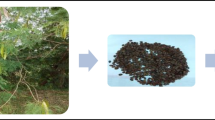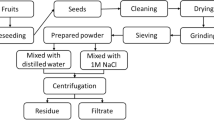Abstract
Present study investigates the coagulation ability of Plantago ovata (P. ovata) seed extracts for turbidity removal. The active coagulant agents were successfully extracted from P. ovata seeds using different solvents such as distilled water (PO-DW), tap water (PO-TW), NaCl (PO-NaCl), and ammonium acetate (PO-AA). Experiments were conducted in batch mode for initial turbidity such as 500 NTU (high), 150 NTU (medium), and 50 NTU (low). Results demonstrated that P. ovata extracts are less efficient in low turbidities, while PO-NaCl was found to provide high coagulation activity in all initial turbidity concentrations compared to other extracts. PO-NaCl was able to remove 98.2, 94.9, and 80.2% of turbidity from water having in initial turbidities of 500, 150, and 50 NTU, respectively. Coagulation activity of the extract was the best when the extraction was performed for 50 min at room temperature. Jar test procedure with the coagulation time of 1 min and flocculation time of 30 min was optimized, irrespective of the initial turbidity. The optimum settling time for 500, 150, and 50 NTU water samples were 20, 30, and 90 min, respectively. PO-NaCl was used in different pH turbid solutions and it was found to be working very efficiently in alkaline conditions. The coagulation efficiency of the coagulant stored in refrigerator was higher than that stored at room temperature. Thus, the natural coagulants extracted from P. ovata seeds revealed to be effective for turbidity removal.







Similar content being viewed by others
References
Anastasakis, K., Kalderis, D., & Diamadopoulos, E. (2009). Flocculation behavior of mallow and okra mucilage in treating wastewater. Desalination. https://doi.org/10.1016/j.desal.2008.09.013.
Ani, J. U., Nnaji, N. J., Okoye, C. O. B., & Onukwuli, O. D. (2012). The coagulation performance of okra mucilage in an industrial effluent by turbidimetry. International Journal of Chemical Sciences, 10(3), 1293–1308.
Antov, M. G., Šćiban, M. B., & Prodanović, J. M. (2012). Evaluation of the efficiency of natural coagulant obtained by ultrafiltration of common bean seed extract in water turbidity removal. Ecological Engineering. https://doi.org/10.1016/j.ecoleng.2012.08.015.
APHA. (1999). Standard methods for the examination of water and wastewater. Washington, DC: American Public Health Association.
Choy, S. Y., Prasad, K. M. N., Wu, T. Y., Raghunandan, M. E., & Ramanan, R. N. (2014). Utilization of plant-based natural coagulants as future alternatives towards sustainable water clarification. Journal of Environmental Sciences (China). https://doi.org/10.1016/j.jes.2014.09.024.
Choy, S. Y., Prasad, K. M. N., Wu, T. Y., & Ramanan, R. N. (2015). A review on common vegetables and legumes as promising plant-based natural coagulants in water clarification. International Journal of Environmental Science and Technology. https://doi.org/10.1007/s13762-013-0446-2.
Devesa-Rey, R., Fernández, N., Cruz, J. M., & Moldes, A. B. (2011). Optimization of the dose of calcium lactate as a new coagulant for the coagulation-flocculation of suspended particles in water. Desalination. https://doi.org/10.1016/j.desal.2011.06.051.
Divakaran, R., & Sivasankara Pillai, V. N. (2002). Flocculation of river silt using chitosan. Water Research. https://doi.org/10.1016/S0043-1354(01)00436-5.
Gandhimathi, R., Durai, N. J., Nidheesh, P. V., Ramesh, S. T., & Kanmani, S. (2013). Use of combined coagulation-adsorption process as pretreatment of landfill leachate. Iranian Journal of Environmental Health Science & Engineering, 10(1), 24. https://doi.org/10.1186/1735-2746-10-24.
Katayon, S., Ng, S. C., Megat Johari, M. M. N., & Abdul Ghani, L. A. (2006a). Preservation of coagulation efficiency of Moringa oleifera, a natural coagulant. Biotechnology and Bioprocess Engineering. https://doi.org/10.1007/BF02932072.
Katayon, S., Noor, M. J. M. M., Asma, M., Ghani, L. A. A., Thamer, A. M., Azni, I., et al. (2006b). Effects of storage conditions of Moringa oleifera seeds on its performance in coagulation. Bioresource Technology. https://doi.org/10.1016/j.biortech.2005.07.031.
Khiari, R., Dridi-Dhaouadi, S., Aguir, C., & Mhenni, M. F. (2010). Experimental evaluation of eco-friendly flocculants prepared from date palm rachis. Journal of Environmental Sciences. https://doi.org/10.1016/S1001-0742(09)60286-2.
McConnachie, G. L., Folkard, G. K., Mtawali, M. A., & Sutherland, J. P. (1999). Field trials of appropriate hydraulic flocculation processes. Water Research. https://doi.org/10.1016/S0043-1354(98)00339-X.
Muthuraman, G., & Sasikala, S. (2014). Removal of turbidity from drinking water using natural coagulants. Journal of Industrial and Engineering Chemistry. https://doi.org/10.1016/j.jiec.2013.08.023.
Ndabigengesere, A., Narasiah, K. S., & Talbot, B. G. (1995). Active agents and mechanism of coagulation of turbid waters using Moringa oleifera. Water Research. https://doi.org/10.1016/0043-1354(94)00161-Y.
Ndabigengesere, A., & Subba Narasiah, K. (1998). Quality of water treated by coagulation using Moringa oleifera seeds. Water Research. https://doi.org/10.1016/S0043-1354(97)00295-9.
Nidheesh, P. V., Thomas, P., Nair, K. A., Joju, J., Aswathy, P., Jinisha, R., et al. (2017). Potential use of Hibiscus rosa-sinensis leaf extract for the destabilization of turbid water. Water, Air, & Soil Pollution, 228(1), 51. https://doi.org/10.1007/s11270-016-3232-1.
Okuda, T., Baes, A. U., Nishijima, W., & Okada, M. (1999). Improvement of extraction method of coagulation active components from Moringa oleifera seed. Water Research. https://doi.org/10.1016/S0043-1354(99)00046-9.
Okuda, T., Baes, A. U., Nishijima, W., & Okada, M. (2001). Coagulation mechanism of salt solution-extracted active component in Moringa oleifera seeds. Water Research. https://doi.org/10.1016/S0043-1354(00)00296-7.
Oladoja, N. A. (2015). Headway on natural polymeric coagulants in water and wastewater treatment operations. Journal of Water Process Engineering. https://doi.org/10.1016/j.jwpe.2015.04.004.
Patel, H., & Vashi, R. T. (2012). Removal of Congo Red dye from its aqueous solution using natural coagulants. Journal of Saudi Chemical Society, 16(2), 131–136.
Prasad, R. K. (2009). Color removal from distillery spent wash through coagulation using Moringa oleifera seeds: use of optimum response surface methodology. Journal of Hazardous Materials. https://doi.org/10.1016/j.jhazmat.2008.10.068.
Ramavandi, B. (2014). Treatment of water turbidity and bacteria by using a coagulant extracted from Plantago ovata. Water Resources and Industry. https://doi.org/10.1016/j.wri.2014.07.001.
Sanghi, R., Bhatttacharya, B., & Singh, V. (2002). Cassia angustifolia seed gum as an effective natural coagulant for decolourisation of dye solutions. Green Chemistry. https://doi.org/10.1039/b200067a.
Šćiban, M., Klašnja, M., Antov, M., & Škrbić, B. (2009). Removal of water turbidity by natural coagulants obtained from chestnut and acorn. Bioresource Technology. https://doi.org/10.1016/j.biortech.2009.06.047.
Shak, K. P. Y., & Wu, T. Y. (2015). Optimized use of alum together with unmodified Cassia obtusifolia seed gum as a coagulant aid in treatment of palm oil mill effluent under natural pH of wastewater. Industrial Crops and Products. https://doi.org/10.1016/j.indcrop.2015.07.072.
Shilpa, B. S., Akanksha, K., & Girish, P. (2012). Evaluation of cactus and hyacinth bean peels as natural coagulants. International Journal of Chemical and Environmental Engineering, 3, 187–191.
Subramonian, W., Wu, T. Y., & Chai, S. P. (2015). An application of response surface methodology for optimizing coagulation process of raw industrial effluent using Cassia obtusifolia seed gum together with alum. Industrial Crops and Products. https://doi.org/10.1016/j.indcrop.2015.02.026.
Teh, C. Y., Budiman, P. M., Shak, K. P. Y., & Wu, T. Y. (2016). Recent advancement of coagulation-flocculation and its application in wastewater treatment. Industrial and Engineering Chemistry Research. https://doi.org/10.1021/acs.iecr.5b04703.
Teh, C. Y., & Wu, T. Y. (2014). The potential use of natural coagulants and flocculants in the treatment of urban waters. Chemical Engineering Transactions. https://doi.org/10.3303/CET1439268.
Yin, C. Y. (2010). Emerging usage of plant-based coagulants for water and wastewater treatment. Process Biochemistry. https://doi.org/10.1016/j.procbio.2010.05.030.
Author information
Authors and Affiliations
Corresponding authors
Rights and permissions
About this article
Cite this article
Dhivya, S., Ramesh, S.T., Gandhimathi, R. et al. Performance of Natural Coagulant Extracted from Plantago ovata Seed for the Treatment of Turbid Water. Water Air Soil Pollut 228, 423 (2017). https://doi.org/10.1007/s11270-017-3592-1
Received:
Accepted:
Published:
DOI: https://doi.org/10.1007/s11270-017-3592-1




